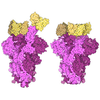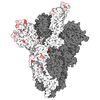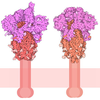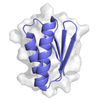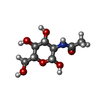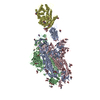+ Open data
Open data
- Basic information
Basic information
| Entry | Database: PDB / ID: 9bll | ||||||
|---|---|---|---|---|---|---|---|
| Title | Cryo-EM of RBD(EG5.1)/1301B7 Fab Complex | ||||||
 Components Components |
| ||||||
 Keywords Keywords | VIRAL PROTEIN/IMMUNE SYSTEM / Fab / RBD / Complex / PROTEIN BINDING / VIRAL PROTEIN-IMMUNE SYSTEM complex | ||||||
| Function / homology |  Function and homology information Function and homology informationMaturation of spike protein / viral translation / Translation of Structural Proteins / Virion Assembly and Release / host cell surface / host extracellular space / symbiont-mediated-mediated suppression of host tetherin activity / Induction of Cell-Cell Fusion / structural constituent of virion / entry receptor-mediated virion attachment to host cell ...Maturation of spike protein / viral translation / Translation of Structural Proteins / Virion Assembly and Release / host cell surface / host extracellular space / symbiont-mediated-mediated suppression of host tetherin activity / Induction of Cell-Cell Fusion / structural constituent of virion / entry receptor-mediated virion attachment to host cell / membrane fusion / Attachment and Entry / host cell endoplasmic reticulum-Golgi intermediate compartment membrane / positive regulation of viral entry into host cell / receptor-mediated virion attachment to host cell / host cell surface receptor binding / symbiont-mediated suppression of host innate immune response / receptor ligand activity / endocytosis involved in viral entry into host cell / fusion of virus membrane with host plasma membrane / fusion of virus membrane with host endosome membrane / viral envelope / virion attachment to host cell / SARS-CoV-2 activates/modulates innate and adaptive immune responses / host cell plasma membrane / virion membrane / identical protein binding / membrane / plasma membrane Similarity search - Function | ||||||
| Biological species |  Homo sapiens (human) Homo sapiens (human) | ||||||
| Method | ELECTRON MICROSCOPY / single particle reconstruction / cryo EM / Resolution: 4.1 Å | ||||||
 Authors Authors | Walter, M.R. / Green, T.J. | ||||||
| Funding support |  United States, 1items United States, 1items
| ||||||
 Citation Citation |  Journal: Npj Viruses / Year: 2024 Journal: Npj Viruses / Year: 2024Title: Potent neutralization by a RBD antibody with broad specificity for SARS-CoV-2 JN.1 and other variants. Authors: Michael S Piepenbrink / Ahmed Magdy Khalil / Ana Chang / Ahmed Mostafa / Madhubanti Basu / Sanghita Sarkar / Simran Panjwani / Yaelyn H Ha / Yao Ma / Chengjin Ye / Qian Wang / Todd J Green / ...Authors: Michael S Piepenbrink / Ahmed Magdy Khalil / Ana Chang / Ahmed Mostafa / Madhubanti Basu / Sanghita Sarkar / Simran Panjwani / Yaelyn H Ha / Yao Ma / Chengjin Ye / Qian Wang / Todd J Green / James L Kizziah / Nathaniel B Erdmann / Paul A Goepfert / Lihong Liu / David D Ho / Luis Martinez-Sobrido / Mark R Walter / James J Kobie /   Abstract: SARS-CoV-2 continues to be a public health burden, driven in-part by its continued antigenic diversification and resulting emergence of new variants. By increasing herd immunity, current vaccines ...SARS-CoV-2 continues to be a public health burden, driven in-part by its continued antigenic diversification and resulting emergence of new variants. By increasing herd immunity, current vaccines have improved infection outcomes for many. However, prophylactic and treatment interventions that are not compromised by viral evolution of the Spike protein are still needed. Using a differential staining strategy with a rationally designed SARS-CoV-2 Receptor Binding Domain (RBD) - ACE2 fusion protein and a native Omicron RBD protein, we developed a recombinant human monoclonal antibody (hmAb) from a convalescent individual following SARS-CoV-2 Omicron infection. The resulting hmAb, 1301B7 potently neutralized a wide range of SARS-CoV-2 variants including the original Wuhan-1, the more recent Omicron JN.1 strain, and SARS-CoV. 1301B7 contacts the ACE2 binding site of RBD exclusively through its VH1-69 heavy chain. Broad specificity is achieved through 1301B7 binding to many conserved residues of Omicron variants including Y501 and H505. Consistent with its extensive binding epitope, 1301B7 is able to potently diminish viral burden in the upper and lower respiratory tract and protect mice from challenge with Omicron XBB1.5 and Omicron JN.1 viruses. These results suggest 1301B7 has broad potential to prevent or treat clinical SARS-CoV-2 infections and to guide development of RBD-based universal SARS-CoV-2 prophylactic vaccines and therapeutic approaches. | ||||||
| History |
|
- Structure visualization
Structure visualization
| Structure viewer | Molecule:  Molmil Molmil Jmol/JSmol Jmol/JSmol |
|---|
- Downloads & links
Downloads & links
- Download
Download
| PDBx/mmCIF format |  9bll.cif.gz 9bll.cif.gz | 115.4 KB | Display |  PDBx/mmCIF format PDBx/mmCIF format |
|---|---|---|---|---|
| PDB format |  pdb9bll.ent.gz pdb9bll.ent.gz | 73.6 KB | Display |  PDB format PDB format |
| PDBx/mmJSON format |  9bll.json.gz 9bll.json.gz | Tree view |  PDBx/mmJSON format PDBx/mmJSON format | |
| Others |  Other downloads Other downloads |
-Validation report
| Summary document |  9bll_validation.pdf.gz 9bll_validation.pdf.gz | 1.4 MB | Display |  wwPDB validaton report wwPDB validaton report |
|---|---|---|---|---|
| Full document |  9bll_full_validation.pdf.gz 9bll_full_validation.pdf.gz | 1.4 MB | Display | |
| Data in XML |  9bll_validation.xml.gz 9bll_validation.xml.gz | 36.6 KB | Display | |
| Data in CIF |  9bll_validation.cif.gz 9bll_validation.cif.gz | 51.4 KB | Display | |
| Arichive directory |  https://data.pdbj.org/pub/pdb/validation_reports/bl/9bll https://data.pdbj.org/pub/pdb/validation_reports/bl/9bll ftp://data.pdbj.org/pub/pdb/validation_reports/bl/9bll ftp://data.pdbj.org/pub/pdb/validation_reports/bl/9bll | HTTPS FTP |
-Related structure data
| Related structure data |  44666MC M: map data used to model this data C: citing same article ( |
|---|---|
| Similar structure data | Similarity search - Function & homology  F&H Search F&H Search |
- Links
Links
- Assembly
Assembly
| Deposited unit | 
|
|---|---|
| 1 |
|
- Components
Components
| #1: Antibody | Mass: 13768.365 Da / Num. of mol.: 1 Source method: isolated from a genetically manipulated source Source: (gene. exp.)  Homo sapiens (human) / Production host: Homo sapiens (human) / Production host:  Homo sapiens (human) Homo sapiens (human) |
|---|---|
| #2: Antibody | Mass: 11517.782 Da / Num. of mol.: 1 Source method: isolated from a genetically manipulated source Source: (gene. exp.)  Homo sapiens (human) / Production host: Homo sapiens (human) / Production host:  Homo sapiens (human) Homo sapiens (human) |
| #3: Protein | Mass: 137934.078 Da / Num. of mol.: 1 / Fragment: RBD(EG5.1) Source method: isolated from a genetically manipulated source Source: (gene. exp.)  Gene: S, 2 / Production host:  Homo sapiens (human) / References: UniProt: P0DTC2 Homo sapiens (human) / References: UniProt: P0DTC2 |
| #4: Polysaccharide | 2-acetamido-2-deoxy-beta-D-glucopyranose-(1-4)-2-acetamido-2-deoxy-beta-D-glucopyranose Source method: isolated from a genetically manipulated source |
| #5: Sugar | ChemComp-NAG / |
| Has ligand of interest | Y |
| Has protein modification | Y |
-Experimental details
-Experiment
| Experiment | Method: ELECTRON MICROSCOPY |
|---|---|
| EM experiment | Aggregation state: PARTICLE / 3D reconstruction method: single particle reconstruction |
- Sample preparation
Sample preparation
| Component | Name: Complex of RBDeg5.1 with Fab 1301B7 / Type: COMPLEX / Details: Fab generated by proteolytic cleavage / Entity ID: #1-#3 / Source: RECOMBINANT | ||||||||||||
|---|---|---|---|---|---|---|---|---|---|---|---|---|---|
| Molecular weight | Experimental value: NO | ||||||||||||
| Source (natural) | Organism:  Homo sapiens (human) Homo sapiens (human) | ||||||||||||
| Source (recombinant) | Organism:  Homo sapiens (human) Homo sapiens (human) | ||||||||||||
| Buffer solution | pH: 7.5 | ||||||||||||
| Buffer component |
| ||||||||||||
| Specimen | Conc.: 1.5 mg/ml / Embedding applied: NO / Shadowing applied: NO / Staining applied: NO / Vitrification applied: YES | ||||||||||||
| Vitrification | Instrument: FEI VITROBOT MARK IV / Cryogen name: ETHANE / Humidity: 95 % / Chamber temperature: 298 K |
- Electron microscopy imaging
Electron microscopy imaging
| Microscopy | Model: TFS GLACIOS |
|---|---|
| Electron gun | Electron source:  FIELD EMISSION GUN / Accelerating voltage: 200 kV / Illumination mode: FLOOD BEAM FIELD EMISSION GUN / Accelerating voltage: 200 kV / Illumination mode: FLOOD BEAM |
| Electron lens | Mode: BRIGHT FIELD / Nominal defocus max: 2000 nm / Nominal defocus min: 750 nm |
| Image recording | Electron dose: 50 e/Å2 / Film or detector model: TFS FALCON 4i (4k x 4k) |
- Processing
Processing
| EM software |
| ||||||||||||||||||||||||||||||||||||||||||||
|---|---|---|---|---|---|---|---|---|---|---|---|---|---|---|---|---|---|---|---|---|---|---|---|---|---|---|---|---|---|---|---|---|---|---|---|---|---|---|---|---|---|---|---|---|---|
| CTF correction | Type: PHASE FLIPPING AND AMPLITUDE CORRECTION | ||||||||||||||||||||||||||||||||||||||||||||
| Particle selection | Num. of particles selected: 1113228 | ||||||||||||||||||||||||||||||||||||||||||||
| 3D reconstruction | Resolution: 4.1 Å / Resolution method: FSC 0.143 CUT-OFF / Num. of particles: 88411 / Algorithm: FOURIER SPACE / Num. of class averages: 5 / Symmetry type: POINT | ||||||||||||||||||||||||||||||||||||||||||||
| Atomic model building | Protocol: RIGID BODY FIT / Space: REAL | ||||||||||||||||||||||||||||||||||||||||||||
| Atomic model building | 3D fitting-ID: 1
|
 Movie
Movie Controller
Controller



 PDBj
PDBj